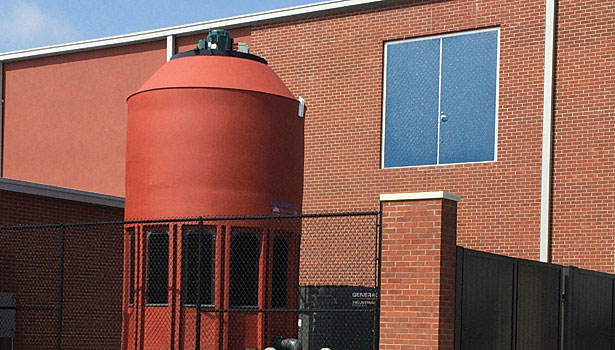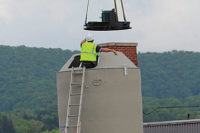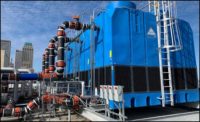When Joe Matthews, vice president of construction at Vista Air Services in Houston, was considering a self-contained, water-cooled HVAC system for a customer near Galveston Bay, he primarily had system efficiencies on his mind. However, since a cooling tower would be essential to the system, he was also concerned about the salt air and corrosive emissions from several surrounding chemical plants that would corrode a conventional, metal-clad cooling tower shell, making frequent maintenance and replacement necessary over the years.
The application was for a 66,000-sq-ft industrial turbine repair station and training facility at Mitsubishi Power Systems for its power generation turbines.
“B.R. Gonzales, a sales rep from AC Engineered Systems, one of our suppliers, suggested that we go with a Delta Cooling HDPE engineered plastic cooling tower because AC has had great success with those in Florida,” explains Matthews. “Considering the potential for salt-air corrosion, we felt that what was appropriate for Florida would also be suitable for a plant in the proximity of Galveston Bay.”
Matthews also figured that the HDPE cooling tower would be cheaper to maintain. He was quite impressed when he learned that the capital investment required would also result in a savings.
“Considering the potential operating savings, I was surprised to learn that the initial purchase price was also substantially lower than many conventional models,” he adds.
The water-cooled system that Vista sold to Mitsubishi was a space-saving design that would economize on plant space compared with some other options.
“We installed four 40-ton air handlers mounted to the exterior walls, plus four 20-ton air handlers inside,” Matthews explains. “With our water-cooled system, we are only taking up less than 30 sq ft.”
According to Delta officials, a deciding factor for most of its cooling tower customers is the 20-yr warranty on the shell, as opposed to one year for the metal-clad design. Also, to ensure optimal operation and ease of installation, Delta offers cooling system design and engineering assistance. When requested, the manufacturer even accommodates customers on cooling tower color.
In an HVAC application, engineered HDPE plastic cooling towers were recently installed at two Scott County Schools facilities in the Georgetown, KY, area.
Adam Berning, sales Engineer with manufacturer’s representative Blackmore & Glunt, explained that the county school board agreed to install HDPE cooling towers because of the economies offered in purchase price and imperviousness to the harsh chemicals required to treat the very hard water used in the system.
The director of maintenance stated that Georgetown has the “worst water on the face of the Earth,” Berning also said they have to frequently clean their cooling towers, removing a salt-like residue that readily accumulates.
He explains a major factor in the school board’s decision for the cooling tower was it would be virtually untouched by any corrosives. But another important value-added factor was Delta’s ability to colorize the cooling tower installed on the roof at one location.
“The board wanted to have one of the cooling towers match the brick exterior of the school where it is installed.” Berning explains. “Ordinarily, getting a colorized cooling tower from the factory would be a challenge. The color was to be a custom rust-brown that the architect specified. Custom colors are available from the factory. They simply inject the appropriate-colored resin into the HDPE to make it exactly the color you want. So, when the cooling tower arrived, it matched the building quite well.”
Berning says that the manufacturer also provided special water drainage outlets and a cooling tower platform.
He adds that the cooling system scheme at one of the schools called for the cooling tower to operate in two stages. Here again value was added through the inclusion of a VFD-compatible fan motor with the cooling tower package.
“The first stage of cooling is provided when water is pumped through the tower without the tower fan running,” Berning says. “As the system fluid temperature rises above a threshold as determined by the building automation system, the cooling tower fan is turned on to provide additional capacity. Once the fan is on, a VFD modulates the fan speed to provide the right amount of cooling. As a standard, the motor provided by Delta Cooling Towers is rated for operation through a VFD, and the VFD they provide easily communicates with the building automation system.”






